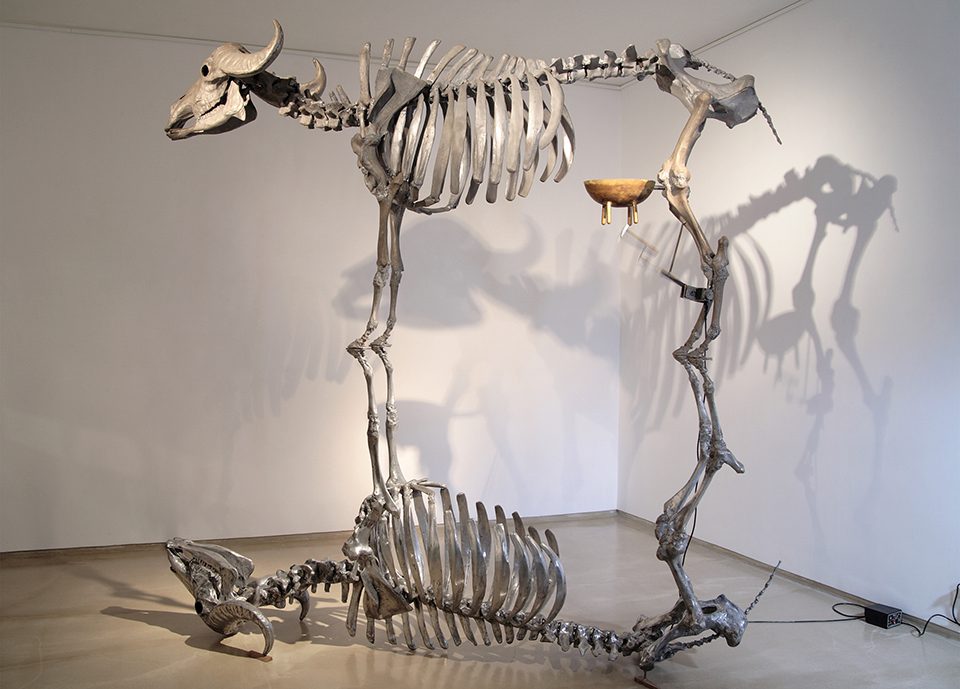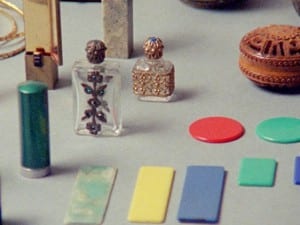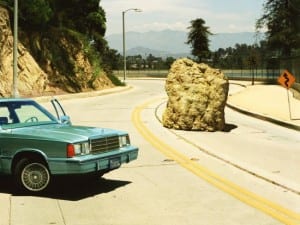In Winter 2008, the Royal Academy of Arts opened its doors to challenging and exciting works of art, that question not only the conceptual, but the theoretical through video installations and performances evoking debate around the nature of contemporary art.
Entering the Royal Academy of Arts main entrance and courtyard is an almost daunting experience; in terms of the architecture, the space feels as if it’s an elitist arts society or club. Perhaps this is why the entrance for GSK Contemporary is around the back of the main building. Jutting onto Burlington Gardens the entrance to the show is flanked on either side by two pairs of contemporary nickel-plated bronze sculptures by Antony Micallef. Certainly not what you would expect of an elitist, staid arts society. The question instantly arises: As an established, private institution founded “to promote painting, printmaking, sculpture and architecture” is it possible for it to re-invent itself to grow with current contemporary art trends and media? It’s a silly question really, with a rather simple answer: Yes.
GSK Contemporary, launched as the new contemporary art season at the Royal Academy, is curated as a series of exhibitions, performances, talks, and screenings meant to stimulate debate. The curator, David Thorp, says: “What we see this season as doing, to a certain extent, is providing an alternative to say something like the Frieze Art Fair, which is very orientated to painting and sculpture and the kind of things that are very easily commodified. Video, film, performance and so on are very much harder to actually treat in that way. There are many artists making wonderful works in those media. It is providing an opportunity to see works that you wouldn’t normally see in somewhere like the Frieze Art Fair or any of the commercial galleries.”
Though not typical of the Academy’s usual roster of exhibitions (currently they are hosting two blockbuster shows: Byzantium 330-1453 and Miro, Calder, Giacometti, Braque: Aimé Maeght and His Artists), this exhibition offers contemporary art aficionados their fix, as well as bringing in a new audience, perhaps not as well versed in contemporary art. It’s easy to forget how foreign and complex modern and contemporary art can actually be for many people. It can be difficult to understand (especially conceptual art) and is thus viewed as somewhat daunting. During the exhibition, while sitting watching Julian Rosefeldt’s The Perfectionist (Trilogy of Failure): Soundmaker, I was approached by a woman, who introduced herself as a psychologist, and proceeded to ask me to, essentially, explain what made this art. It’s a difficult question to ask and an even more difficult question to answer.
How do you sum up the meaning and technical and aesthetic merit of a piece of art? Specifically, a three-part video installation being exhibited as part of a show entitled Molten States? I highly doubt I provided her with an answer; if anything my reply probably just confused her further — because there is no real answer. The fact that this exhibition, and Rosefeldt’s piece, instigated her to ask the question proves the very intrinsic worth of this show. David Thorp, states in the leaflet accompanying the exhibition that, “Molten States provides an overview that explores the anxiety that is part of the modern condition and its relationship to issues that exacerbate contemporary life.” Rosefeldt’s trilogy, which examines the psychological phenomena of perfectionism and obsessive compulsive disorder through three men within three very different scenarios, brings to light the banal undertakings that afflicted patients endure to achieve a semblance of order within their own lives. The psychologist understood this and in theory she understood the work — what she was aiming to understand was the artistic and technical skill involved in manipulating the sets, filming with 16mm, and composing the narratives that Rosefeldt had achieved.
Thorp curated GSK Contemporary in two parts: Molten States and Collision Course, with Collision Course further divided into three exhibitions (Sudden White (after London), Dark Materials and Burroughs Live). This series is especially important in that it focuses on the idea of the aftermath and a post-apocalyptic world; relevant in today’s current economic and political climate, which is characterised by instability and volatility. Thorp resists the assumption that Collision Course, and specifically Dark Materials, is thematically dark and heavy: “The work in Dark Materials is really quite exciting. It’s not a kind of ponderous, gloomy experience. People will be stimulated by it, not brought down by it.” Art has the ability to make tangible our fears of collapse and ruin and this exhibition encapsulates that, yet it also uses humour to lighten the mood of the show.
The season is primarily focused on the reception of the works by the audience. Thorp hopes that attendees will visit not just once but numerous times, whether to see a specific screening or the exhibition itself. He has therefore purposefully selected artists that involve the audience — either directly through their installations or on a subtler nuanced level. The series is meant to encourage a familiarity with contemporary art and he states: “We wanted more of a season rather than something people just arrived at, saw once and went away. We wanted to enliven the building over a period of time.” Works, such as the group collective Urbania’s open studio / installation (which contains objects and documentation from a week-long residency at Parkamoor, in the Lake District), invites viewers to experience, albeit on a much smaller scale, Urbania’s own experience during the residency. There are no ropes cordoning the works off from the public or guards supervising you to make sure you don’t get too close, as one typically experiences when viewing an exhibition. Thorp is almost inviting you to get too close — to see the art on your own level rather than as a sacred object to be placed on a pedestal.
The interaction between video, performance and theatre is targeted as the main theme for Molten States. Thorp, building towards the idea of the aftermath, has chosen artists such as Georgina Starr and René Pollesch to stage performances and leave the detritus and remains as the documentary evidence of the event. Starr’s Six Sculptures exemplifies this method of documentary performance: broken fragments of six sculptures of the female nude litter the entrance to the café on the second floor of the galleries, instantly causing concern and interest. Who destroyed these sculptures and why? Female artist destroying female nudes: is she making a comment about male-domination in the art world? Or the objectification of women and the female body in society? Starr is provoking the viewer — necessarily causing them to interact with the piece on an intellectual level and to question the meaning of the piece. By temporally staging the performance at the beginning of the exhibition, Starr is prohibiting the audience from creating a relationship with the sculptures and their subsequent destruction therefore feels less like a betrayal of sculpture by artist.
GSK Contemporary is important in that, unlike other exhibitions put on by major institutions, it is purposefully provocative. There is always the worry that when exhibitions are sponsored by a large conglomerate or business, such as GlaxoSmithKline, that the curator and / or institution will permit the company to have a say or presence in the curatorial side of the exhibition. It’s a valid cause for concern: offend the title sponsor and you risk losing the financial support. Thorp is quite adamant in this regard: “They’re not involved in the curatorial side of things. What goes in the programme is really decided by me. They haven’t been involved in that at all.” Thankfully so, because this season is sure to involve a tremendous amount of interest if Molten States is anything to go by.
GSK Contemporary was on as Molten States (31 October – 7 December 2008) and Collision Course (16 December – 9 January 2009), with performances and screenings throughout the series. www.royalacademy.org.uk
Niamh Coghlan





